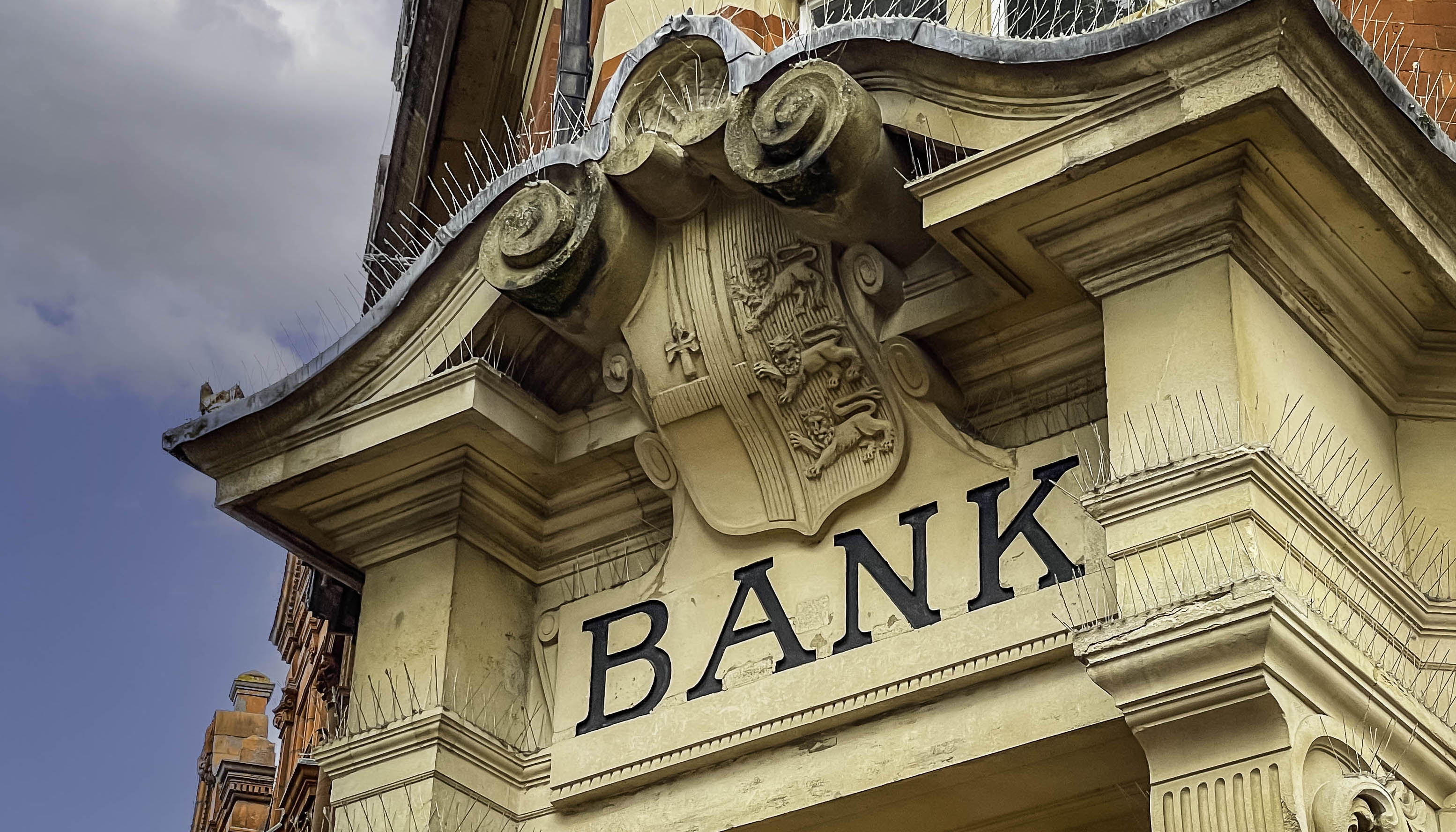Counterparty
Friday, March 22, 2024
By John Hintze
Leading the charge into what has become known as private credit, private equity (PE) firms are “originating loans at scale and holding on to them – an activity traditionally done by banks.” One of the biggest, Apollo Global Management, “is now operating 16 loan origination platforms, ranging from middle market lending to equipment finance to trade finance.”
So observed U.S. national bank regulator Michael Hsu in a February speech at Vanderbilt University. Because such activities push against, or blur the lines of, regulatory boundaries, the acting Comptroller of the Currency suggested that they raise supervisory and macroprudential issues and deserve scrutiny from the Financial Stability Oversight Council (FSOC) and other bodies concerned about potential systemic vulnerabilities.
Hsu further discussed the evolving structures and time horizons of closed-end PE funds, which, while responding to changing dynamics in the credit marketplace, “can introduce new risks, including redemption risks similar to those faced by open-end bond funds, which have been cited as a financial stability concern by the FSOC” and the Securities and Exchange Commission.
He noted PE firms’ increasing “their holdings of insurance companies, which can provide a steady supply of premiums to invest, including in private credit”; quoted the International Monetary Fund’s Global Financial Stability Report on how some PE firms have established offshore reinsurance companies to support their insurance activities and serve as holding companies for affiliates; and said, “The intermingling of funds and opacity of inter-affiliate risk transfers is reminiscent of practices at AIG before it collapsed in 2008.”
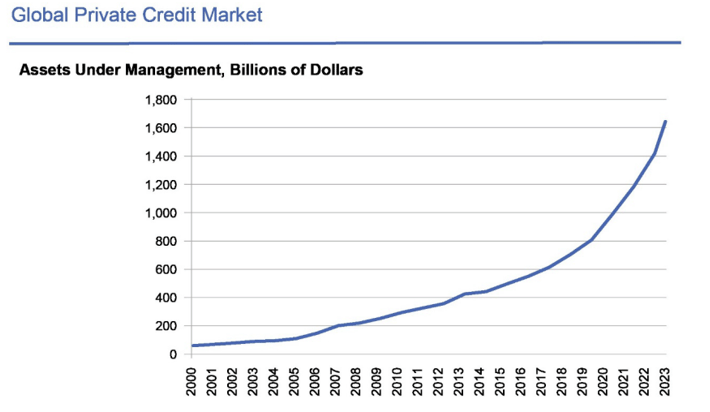
Source: Office of the Comptroller of the Currency (speech). Data from Prequin aggregates dry powder and unrealized value as of year-end, except for 2023 as of June.
Alarms were also being sounded on Capitol Hill. Two Senate Banking Committee Democrats, Chair Sherrod Brown of Ohio and Jack Reed of Rhode Island, called to the attention of principal regulators “the potential risks that private credit may pose to the safety and soundness of our banking system.”
“Private credit has developed significant interconnections with the banking system,” the senators wrote in a November 29 letter to Hsu, Federal Reserve Vice Chair for Supervision Michael Barr and Federal Deposit Insurance Corp. Chair Martin Gruenberg.
“Banks have engaged in lending to private credit funds, are partnering with funds to actively arrange private credit deals, and have begun transferring risk to private credit funds through exotic financial instruments,” they asserted. “These linkages may pose hidden dangers to the banking system, especially as most of the private credit market has not endured a full economic cycle with elevated default rates. Given the sector’s expectations of rapid growth, these risks are already increasing as private credit fund managers continue to collect cash and deploy it on riskier deals.”
As a form of direct lending, a long-standing practice typically involving one or a few lenders providing unrated loans to middle-market companies, private credit can be a benefit to challenged borrowers as well as investors in broadly syndicated bank loans (BSLs).
Generally much smaller than BSLs, those credits carried strong covenants and could be negotiated quickly with lenders that demanded higher returns but worked closely with borrowers when hiccups occurred. BSLs are purchased by various institutional investors, with collateralized loan obligations (CLOs) buying more than 60%.
Rapidly rising rates have pressured the credit ratings of highly leveraged companies’ BSLs. Many have slipped below B-/B3 Standard & Poor’s and Moody’s Investors Service ratings, a tipping point that can significantly impact CLOs. When loans in CLO portfolios are downgraded, cash flows may be diverted from reinvestment or equity investors to support senior tranches if CLOs’ asset-to-liability and par coverage levels drop below predefined levels. To avoid that, CLOs’ early warning systems limit the loans rated CCC or below in the collateral pool.
“In the CLO’s reinvestment period, the manager can trade in and out of loans to manage collateral deterioration, so that coverage tests go back to normal,” said Elen Callahan, the Structured Finance Association’s head of research and education.
Private credit has facilitated that process. In fact, private credit CLOs, also referred to as middle-market CLOs, saw their share of the overall CLO new-issue market rise to 25% last year from 10% in 2022, with 30% expected this year.
Daniel Wohlberg, principal at Eagle Point Credit Management, said that rather than encroaching on the BSL CLO market, private credit is buying “fringy,” seasoned loans on the margin of CLO managers’ portfolios.
“Private credit comes in, and all of a sudden the CLO gets par dollars on a loan that might have been worth much less,” Wohlberg said. “So far, private credit growth has been very positive for BSL.”
For borrowers, interest payments may be somewhat higher, but they are dealing directly with one or a few lenders, rather than the hundreds that can participate in more liquid BSLs. That speeds up the loan process and facilitates potential loan modifications later.
“In the private credit market, both sides – lenders and borrowers – have a better idea about what they’re getting into,” said Ian Walker, head of legal innovation at Covenant Review. “Borrowers can negotiate issues, such as an acquisition, that may not be permitted by the documentation, whereas flexibility to do acquisitions would be built into the documentation for BSLs.”
What’s more, unrated private loans avoid the lengthy rating-agency process and may offer more accommodating terms. A company restricted to four times leverage to get a single B rating may be able to pay slightly more for private credit and get additional leverage.
“Private credit lenders can be more flexible in making loans, because explicit credit ratings are typically a less important factor in evaluating the credit,” said Andrew Berlin, director of policy research at the Loan Syndications and Trading Association (LSTA).
There is a lot of dry powder (more than $400 billion globally, according to a December S&P Global Ratings analysis) for private credit lenders to deploy. Powerhouses including Apollo, Blackstone and Blue Owl Capital are driving the increase in private credit, and newcomers are flocking in.
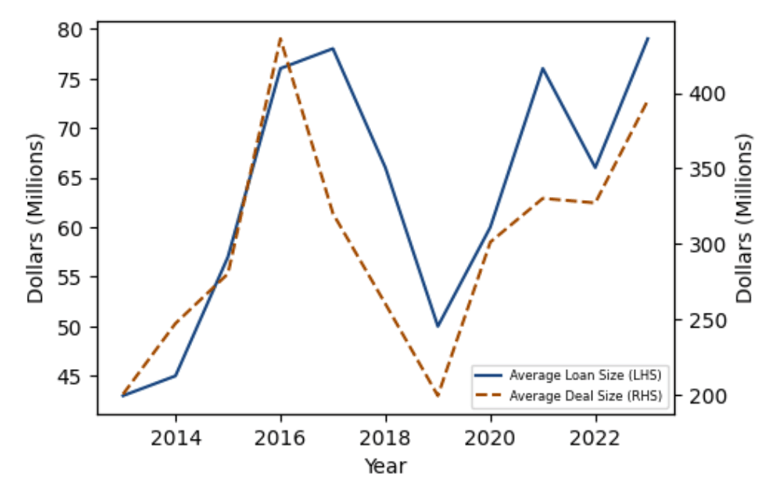
Chart showing average loan size (left scale) and deal size (right scale) across the loan-year distribution, from FEDS Notes, Private Credit: Characteristics and Risks, February 23, 2024.
“Creating a world-leading Infrastructure private-markets investment platform” was an objective of BlackRock’s January agreement to acquire Global Infrastructure Partners.
Goldman Sachs secured a $1 billion investment from Abu Dhabi’s Mubadala sovereign wealth fund for private credit opportunities in Asia. Goldman said it planned to double its $110 billion in private-credit assets under management, Bloomberg reported. Also according to Bloomberg, “Apollo aims to raise its annual origination of private credit to $200 billion to $250 billion in five years,” from about $100 billion.
Goldman Sachs Asset Management has a five-year private credit portfolio target of $300 billion, Marc Nachmann, global head of asset and wealth management, told Reuters.
“A lot of transactions are dual-tracked currently, which means they’re exploring both the private credit and BSL options to determine which will give more favorable terms,” Berlin said.
Private credit deals are also getting larger. Historically they were under $500 million; several last year exceeded $1 billion, including a record $4.8 billion loan supporting Vista Equity Partners’ refinancing of Finastra Group Holdings’ debt. In September, Hyland Software closed a $3.4 billion private term loan and revolving credit that, according to Pitchbook, excluded maintenance covenants providing early credit warnings, the so-called covenant-lite feature common among BSLs.
Heated competition may lead to more private deals with looser terms. Overall, however, only about 25% of private-credit deals are cov-lite, compared to north of 90% of BSLs, Walker said. “Cov-lite is the norm for BSL and the exception for private credit.” Covenant Review has also found better-quality loan documentation in private credit deals to protect lenders.
Larger deals are also likely to lead to larger syndicates of lenders that resemble the BSL market’s but without the regulatory oversight of the commercial banks that structure and lead BSLs. And regulators appear to be taking notice.
Under the heading “What Could Go Wrong?”, the S&P credit analysts said that even moderate stress could cause downgrades of private-credit borrowers; information asymmetry between lenders and equity investors can be “exacerbated by the influx of less-sophisticated retail investors into the asset class; and “illiquidity could reveal contagion risk.”
Last September, the International Organization of Securities Commissions (IOSCO) focused on four themes in a report on Emerging Risks in Private Finance: transparency, leverage, market integrity and risk transmission to the public markets. To LSTA’s Berlin, that was “some guidance as to what regulators are thinking and where they’re looking.”
In December, the Federal Reserve, FDIC and Comptroller of the Currency issued a proposal for revised call report requirements that would include more nondepository and private credit data.
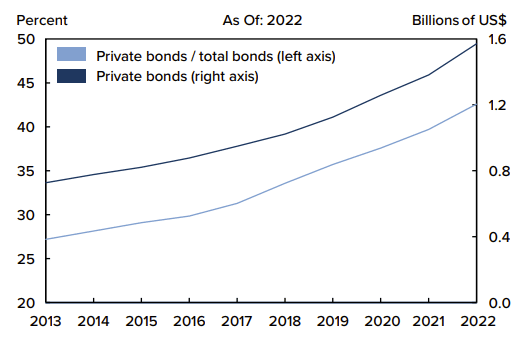
Life and health insurers’ private credit exposure, as shown in the FSOC annual report (S&P Capital IQ data).
With the November release of an analytic framework for financial stability risks and Nonbank Designations Guidance, the FSOC “has more flexibility to make that designation” of these institutions’ systemic importance, Berlin said, though it remains to be seen when or if the authority will be exercised.
Acting Comptroller Hsu said in his Vanderbilt speech that the FSOC’s analytic framework “has three distinct parts: the identification of potential systemic risks, the assessment of such identified risks, and responses to the risks assessed that pose a threat to financial stability.” He spoke of a “trip wire approach to the identification of potential financial stability risks,” where the FSOC would establish metrics and thresholds – through a transparent public-comment process – that would trigger the assessment of systemic risk.
For a hypothetical “PE’s pivot to private credit, expansion into insurance, and innovation with funding structures [that] could raise financial stability questions,” an FSOC trip-wire metric “could be complemented by a scalar for fund structures and affiliated insurance activities,” Hsu explained. “Closed-end funds with long lock-up periods would have a lower scalar than innovative, non-closed-end fund structures, such as evergreen funds. Private credit funds with no links or affiliations with PE-influenced insurers or reinsurers would have a lower scalar than those with links and affiliations.”
Refinancings in the BSL market suggest that the trend of BSLs moving to private credit may be turning. In a strong economy with falling rates, easing leveraged companies’ financial stress, more loans may return to the BSL market, and private-credit portfolios should strengthen. However, there may be rough times ahead for some market participants.
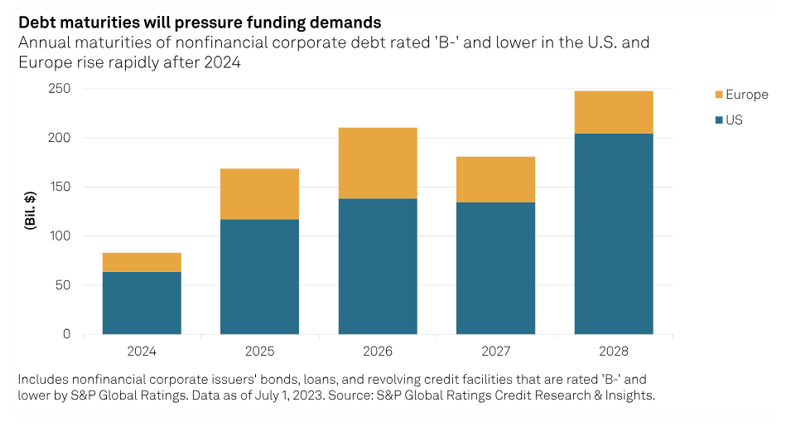
S&P anticipates the trailing-12-month speculative-grade U.S. corporate default rate reaching 5% by September, up from 4.1% a year earlier. It notes that even moderate stress – SOFR rising 1% over S&P’s current base case of 5%, and EBITDA falling by 20% – could result in just 35% of private-credit borrowers generating positive free operating cash flow, and about 28% of those with B estimated credit scores facing downgrades.
“We think the scale of private debt is unlikely on its own to threaten financial stability in the U.S. or Europe, as it accounts for only about 4% and 1% of total nonfinancial corporate debt in each region, respectively,” said S&P Global Ratings’ December report. “However, a material shock in this opaque, illiquid and unregulated market could expose vulnerabilities elsewhere in the financial system.”
Contagion could affect banks, insurers and pension funds. “Banks often provide private credit lenders with some of the capital they use to extend loans – in some cases to companies the banks themselves would consider uncreditworthy,” S&P added.
The Financial Stability Oversight Council put it this way in its 2023 annual report:
“Private credit is a relatively opaque segment of the broader financial market that warrants continued monitoring. Despite its accelerating growth, private credit still represents a relatively small portion of the U.S. economy and also presents limited liquidity transformation risks. However, the extent to which the private credit market poses financial stability risks remains uncertain.”
Some big players see volatility providing opportunities. Daniel J. Ivascyn, group chief investment officer at PIMCO, noted in a recent online commentary the significant credit deterioration in segments of the leveraged lending market. PIMCO sees private loans originated today and over the next few years providing attractive returns, with the caveat that large private-capital lenders’ battling for market share and scale can lead to less credit protection and more aggressive underwriting.
“You want to be selective, careful of capacity management, and be in the areas that are more complex but perhaps a bit less trafficked,” Ivascyn said.
•Bylaws •Code of Conduct •Privacy Notice •Terms of Use © 2024 Global Association of Risk Professionals



